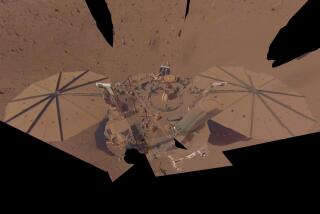Jupiter’s Ganymede has underground ocean: One more ‘soggy’ moon
- Share via
Astronomers have found the most conclusive evidence yet that a large watery ocean lies beneath the surface of Jupiter’s moon Ganymede.
With the discovery, Ganymede joins Enceladus and Europa as another moon in the solar system with a confirmed subterranean ocean.
“The solar system is now looking like a pretty soggy place,” said Jim Green, director of planetary science at NASA. “The more we look at individual moons, the more we see that water is really in enormous abundance.”
And where there’s water, there’s a chance of life.
Scientists have suspected for decades that a subterranean ocean might slosh between the rocky mantle and icy crust of Ganymede, the largest moon in our solar system, but they had not been able to prove it definitively until now.
Using the Hubble Telescope, a team of researchers has detected slight fluctuations in two bands of glowing aurorae in Ganymede’s atmosphere that they say could occur only if the moon contained a salty body of water.
Ganymede is the only moon in the solar system that has its own magnetic field. However, it is also affected by the magnetic field of Jupiter - the giant planet next door.
The effect of Jupiter’s magnetic field on Ganymede changes every 10 hours, which is the length of time it takes the planet to make a full rotation on its axis. For five hours its magnetic field points toward Ganymede, then for another five hours it points away.
“It’s like a lighthouse,” said Joachim Saur of the University of Cologne in Germany, who led the research.
Saur figured that these regular shifts in Jupiter’s magnetic field would affect the position of the aurorae in Ganymede’s atmosphere differently depending on whether or not the moon has a subsurface ocean.
Computer models show that if Ganymede did not have a subsurface ocean, the changes in Jupiter’s magnetic field should cause the bands of hot, electrically charged gas to rock six degrees over a 10-hour period. However, if the moon contained a salty ocean, it would reduce the rocking of the auroras to just two degrees.
The reason for the difference is that a saltwater ocean is electrically conductive and creates a secondary magnetic field that would suppress the effects of Jupiter’s magnetic field.
Saur looked at measurements taken by the Hubble Telescope in 2010 and 2011 of auroras over both the north and south poles of Ganymede and saw that the auroras only moved two degrees over a seven-hour period.
“We ran more than 100 models on supercomputers with different parameters, but every time we got the same result - with no ocean present the aurorae rock by six degrees, if you add an ocean it reduces the rock to two degrees,” Saur said at a news conference Thursday announcing the findings.
As astronomers continue their search for life elsewhere, this technique could help them to identify what other bodies might harbor water and, perhaps, life forms beyond Earth.
“Imagine a magnetically active star with a planet close by,” said Heidi Hammel, executive vice president of Assn. of Universities for Research in Astronomy. “By monitoring the auroral activity on that exoplanet we can infer the presence of water.”
A telescope larger than Hubble may be required to observe distant aurorae, but “now we have a tool that we didn’t have before,” she said.
Science rules! Follow me @DeborahNetburn and “like” Los Angeles Times Science & Health on Facebook.






